 Saturday - May 24, 2008
Saturday - May 24, 2008
Humpback Whales Make Amazing Comeback: Climate And Diet May Be Key
A bit of learning for a Saturday. Why turn on the TV when BMEWS can bring you the latest bits of science and nature to help you entertain your 4 year old? This is from an email I got from Knowledge News. Sign up for just $39 you can get access to all sorts of interesting stuff, forever.
Species Safety In Numbers?
Whale watchers worldwide got a bit of good news this week, with the release of a new study that says humpback whales are making a comeback in the North Pacific.
According to the study, the number of whales in the North Pacific may have reached 20,000 for the period between 2004 and 2006. That’s up from a total of fewer than 1,500 whales 40 years ago, when humpback hunting was banned.
Experts still worry that some humpback subgroups are taking longer to bounce back, but one described the news as “definitely very encouraging in terms of the recovery of the species.” It’s certainly enough to make us want to dive in for a closer look at one of the ocean’s marvelous mammals.
Other experts are thrilled that the humpback’s number have increased so dramatically, and wonder weather climate change and dietary change may have something to do with it. “A humpback cow only calves once every 7 years. She gives birth to a single calf, and that calf isn’t ready to breed until she’s 10 years old. Considering the standard rate of infant mortality among even the higher mammals in the wild, something unusual must be going on. To get these kind of numbers in just 40 years means that not only are the females surviving more than we expected, they must be growing faster and breeding younger. Slightly warmer seawater from climate change means the whales have to spend less energy to stay warm, and that helps. But that isn’t enough; they must be getting much higher levels of protein in their diets than you would normally get from eating a ton or so of krill every day.”
Uproarious Rorquals
Humpbacks hail from the family of whales called “rorquals,” which includes the fin whale, the sei whale, and the blue whale, the world’s largest animal. Blue whales can grow to 100 feet (30 meters) and weigh up to 330,000 pounds (150 metric tons), bigger than any dinosaur we’ve yet discovered.At 45 feet (14 meters) and 80,000 pounds (36 metric tons), humpbacks aren’t nearly as big as cousin Blue. But they can really sing. In fact, according to a 2006 study, humpback whales sing grammatically, combining sounds into phrases, and phrases into songs, according to complex rules called a “hierarchical syntax.” It’s similar to our ability to combine words into clauses and clauses into sentences.
Humpbacks can dance, too. They are among the most acrobatic of whales, sometimes leaping entirely out of the water. Such breaching is common among males during mating season, when humpbacks migrate from polar feeding grounds to tropical breeding grounds. It’s also during mating season that humpback males sing their syntactically sophisticated songs, presumably in pursuit of humpback gals. Until recently, breaching had only been observed in the breeding grounds. Recent whale studies though have found humpbacks breaching in the ice littoral areas on the edge of the polar regions. That’s the edge of the pack ice which in the spring becomes a morass of small bergs and chunks of ice. Humpbacks have been observed breaching right next to smaller pieces of the flow, and sometimes even striking the edge of them without apparent injury. Needless to say, 36 tons of flying whale hitting a bit of ice sheet sends the ice tumbling. Humpbacks are also known to “hover” by resting vertically at the surface with their heads protruding from the water. It is thought that this lets the humpbacks have a look around above the water. Breaching may let them see even further, possibly in an attempt to spot schools of fish feeding at the surface nearby. This is a very hotly debated subject amongst whale researchers.
Straining for Snacks
Like all rorquals, humpbacks are baleen whales. They feed by taking huge mouthfuls of seawater--literally tons of it--then forcing the water out between hundreds of plates of baleen (a.k.a. “whalebone") that hang from the roofs of their mouths. The baleen plates work like a sieve, letting water out but keeping krill and other munchable marine life in.
To catch that seafood dinner, humpbacks sometimes use a special technique called “bubblenet.” First, one or more humpbacks swim in a circle beneath a school of fish, blowing bubbles that float up to form a wall around their prey. Then the humpbacks swim up through their “bubblenet,” slurping the fish-filled water as they go. Bubblenetting is a typical humpback feeding behavior. In the polar regions a pod of whales will often bubblenet around smaller pieces of loose pack ice. The very warm airbubbles are thought to confuse and dislodge small fish and other creatures that use the ice as cover.
Lunge feeding
Humpback whales have yet another ingenious way of getting thier dinner called lunge feeding. Instead of slowly trawling along processing thousands of gallons of seawater for the occassional shrimp, humpbacks also engage in this type of nearly hunting behavior. Whether alone or in pods, whether used with a bubblenet or not, tropical or polar, sometimes humpbacks will dive deep, turn around, and race towards the surface. As they get there they open their mouths wide and snap up whatever they find. Whale research scientists are very impressed with lunge feeding. “There are some fish that live near the surface. If the whales were to come up behind them the fish would sense it and dart away. It’s like trout and mayflies, only much much larger. Lunge feeding lets the whale catch much bigger creatures we ever realized, especially when they are in a pod in the arctic and making bubblnets. The old idea of the giant gentle humpback getting by on enormous amounts of plankton may just have to be tossed overboard.”
It’s clever, and tremendously effective. A humpback whale can catch, and eat, as much as 3,000 pounds (1,360 kg) of food in a day. But that’s not too surprising--coming from a creature smart enough to sing in syntax. Every year brings exciting new discoveries in the field of whale science. Subscribe to Knowledge News today so you can stay informed!
UPDATE !! Breaking News: researchers find the humpback’s secret protien source.
Posted by Drew458
Filed Under: • Amazing Science and Discoveries • Animals •
• Comments (2)
 Monday - May 12, 2008
Monday - May 12, 2008
‘Mobile’ phone enjoys centenery
My contribution to the world of hi-tek news for today.
It is much harder to spot in the online version but ..... see the group of three ppl off to the right? OK .. There’s a huge metal ring (Xmitter) in that area.
Here, you can just (with some difficulty) make out part of the loop. Or circle that is part of the equipment.
By Joanna Corrigan
Last Updated: 11:30PM BST 11/05/2008
Photographs of the world’s first “wireless telephone” have revealed that it was not quite as mobile as its modern counterparts.

Invented by Nathan Stubblefield in 1908, the device came complete with an unwieldy metal transmitter.
A far cry from the tiny mobile phones in use today, the telephone was made up of a system of wire suspended between metal rods with the transmitter placed on a train carriage or boat.
When the vehicle neared, a signal was sent through the air to the telephone using magnetic fields. It could be heard near the other end of the wire through another phone.
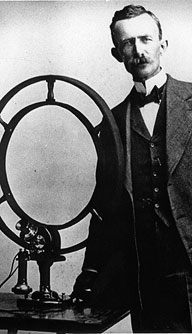
One hundred years on, Stubblefield is finally being recognised as the inventor of the mobile phone. Just 30 years after the first proper long-distance phone network was set up, the Kentucky melon farmer was awarded the patent for his “wireless telephone”.
Stubblefield created the “portable” phone after managing to send his and his son’s voices between early telephones through the ground and even through water.
His device never caught on but now he is being honoured with his very own page on the Virgin Mobile website to mark the anniversary of his creation.
Virgin’s founder Sir Richard Branson said: “Nathan is the father of the mobile phone and I’m thrilled we can celebrate the 100-year anniversary of his invention that in some way went on to change the way the world communicates.”
Mr Stubblefield was granted a patent for his invention in 1908
http://tinyurl.com/5xw4vx
Posted by Drew458
Filed Under: • Amazing Science and Discoveries • History •
• Comments (0)
 Thursday - May 08, 2008
Thursday - May 08, 2008
More Mil Blogging - Next Generation of Munitions?

The Pentagon has quietly been working on a new arsenal of advanced weaponry that replaces metal casings with “reactive materials,” ("RM") normally harmless matter that combines to release explosive amounts of energy on impact, tearing targets apart with violent fury.
In development for more than 30 years, the research is beginning to bear fruit, and may soon spawn more powerful bombs, warheads that tear apart stone and concrete, mines that can be set to stun or kill, and grenades that can swat rockets or mortar rounds out of the sky like flies.
A very long time ago, there was this English guy who invented the exploding cannon ball. His name was Shrapnel. Since that time, almost all military explosive devices have followed his basic concept: shoot something made out of iron at your enemy, and have it blow up when it gets close. The flying fragments - the shrapnel - will inflict the damage, much more than the blast will. But that was back in the day, when the best blast that could be made was provided by black powder. Modern explosives are orders of magnitude more powerful. And we have learned how to focus the explosions themselves. So while a typical standard artillery shell or aerial bomb might be half explosive and half fragmentable iron casing, more modern weapons don’t use much casing at all. Bombs like the MOAB and the Daisy Cutter do their damage based on massive shockwaves, not flying fragments. Focused explosives, otherwise known as shaped charges, came out in WWII (eg the bazooka, an early RPG), and were found able to defeat significant amounts of armor by creating a high velocity plasma jet that burned through everything. Shaped charge weapons are still used today, and we’ve even learned how changing the shape of the Shape makes them even more potent. A simple shaped charge IED with a couple pounds of explosive can defeat a full size tank with ease. So do we really even need shrapnel any more? Well, what if the shrapnel itself was another kind of explosive? How about a plasma jet that cuts through armor and then blows up? Or a shaped charge shell of a given size that’s suddenly 3 times as potent?
Shaped charges are another application where RMs can increase the effectiveness of existing designs. In a shaped charge, a hollow metal cone is surrounded by explosive material, which is then detonated, forcing the blast through the small end of the cone.
“The action is analogous to stamping on an open toothpaste tube, ejecting the liquid contents,” says Douglas Millard of British defense contractors QinetiQ.
Replace the metal liner with RM, and the explosive power of that jet will increase dramatically.
“Such reactions are highly exothermic and therefore lead to the release of large amounts of energy, which is in addition to the kinetic energy within the jet,” Millard says. “An increase in the energy coupled into the target occurs and this results in the creation of greater damage to the target.”
Reactive materials are combinations of materials that are normally stable, but, when subjected to sudden shock—such as striking a target—release a large amount of energy. Depending on the composition and warhead design, the energy can be released as heat, a blast or a combination of the two. Unlike conventional explosives, RMs cannot be set off by fuses. Technically, they are classified as flammable solids, and they are less hazardous to transport and store than explosives.
...
The material can dramatically magnify the yield of conventional bombs, and do away with the waste embodied by a bomb’s inert metal skin.
...
a new bomb could be half the size of existing weapons but twice as powerful.
Pretty damned amazing. But along with the “smaller but more potent” meme comes the “minimal force” meme. Eliminating flying shrapnel cuts down the kill radius of a bomb, which would lessen the chance for collateral damage.
The BattleAxe warhead program is funded by the Air Force Research Laboratory at Eglin Air Force Base, Fla. The goal of this program is to develop a multi-role, miniature warhead. BattleAxe uses material which allows a smaller warhead to destroy targets completely without causing major collateral damage to the surrounding areas.
Potential targets for the BattleAxe include, unarmored and armored vehicles, buildings in urban environments, and other potential threats. Applications for this warhead include low-cost mini-cruise-missiles and weaponized unmanned aerial vehicles, allowing greater protection for deployed troops in hostile environments.
There are huge advantages to smaller more efficient projectiles. They can be fired faster and further with the same amount of propellent. The guns or missiles that propel them can be smaller and lighter. Possibley they cost less, and since they’re smaller and lighter, more of them can be carried along for a given weight. That the little ones can be as effective, or even more effective, than the older bigger ones is sweet icing on the cake.
The RM project has been going on for 30 years now. There have been many obstacles to overcome. Are we close to seeing these things actually fielded, or is this article just a puff piece for a defense contractor who is up for grant renewal?
Normally new weapons are fielded rapidly if there is a military demand—assuming they work. So far, RMs have not made it into the field, and the technology may not be as mature as developers suggest. But Pike also notes that there has been an unprecedented surge in munitions development over the last few years, with “all kinds of weird stuff” being developed. So after decades of being kept very quiet, reactive materials may soon be making a lot of noise.
Posted by Drew458
Filed Under: • Amazing Science and Discoveries • Military •
• Comments (6)
 Tuesday - May 06, 2008
Tuesday - May 06, 2008
Huge Black Hole Kicked Out Of Universe, Hillary Loves The Concept
Since Steamboat McGoo is on a road trip this week and thus unable to blog, I figured I’d try my hand at his style of posting. Hey, this is fun!
A colossal black hole has been spotted exiting its home galaxy, kicked out after a huge cosmic merger took place. The event, seen for the first time, was announced last week. When two colliding galaxies finally merge, it is thought that the black holes at their cores may fuse together too.
Astronomers have theorized that the resulting energy release could propel the new black hole from its parent galaxy out into space, but no one has found such an event.
“We have observed the pre-merger stages of black holes,” said Stefanie Komossa of the Max Planck Institute for Extraterrestrial Physics, part of the team that made the new discovery. “But we haven’t seen the actual merger event.”
Komossa and her team have now detected the consequences of such a merger: a 100-million-solar mass black hole in the process of leaving its home galaxy.
“The consequence was that the merged black hole, the final product, the new black hole was expelled from the galaxy,” Komossa said.
The team’s results are detailed in the May 10 issue of the journal Astrophysical Journal Letters.
Our own Milky Way contains the debris of the many smaller galaxies it has brushed against and devoured in the past. And it hasn’t stopped munching away at its neighbors: It is currently absorbing the Sagittarius dwarf elliptical galaxy.
The Milky Way isn’t the top predator though, as our giant neighbor, the Andromeda galaxy, is expected to devour the Milky Way in about two billion years. The future resulting elliptical galaxy has already been dubbed “Milkomeda.”
Though colliding galaxies rush towards each other at hundreds of kilometers per hour, the interactions can take hundreds of millions of years to complete.
This game of celestial bumper cars is driven by the gravitational pulls that galaxies exert on one another. Typically the first sign of a collision is a bridge of matter connecting two galaxies as gravity’s first gentle tugs tease out dust and gas. As the outer reaches of the galaxies begin to interact, long streamers of gas and dust, called tidal tails, sweep back to wrap around the galactic cores.
The only thing missing from these articles is some vector info about the runaway black hole. Since they don’t tell which way it’s going, that can only mean that it’s headed straight at us. We’re all gonna die!!!
To make you feel a little better while you ponder your doom, here is some smut.
Posted by Drew458
Filed Under: • Amazing Science and Discoveries • Eye-Candy • Fun-Stuff •
• Comments (4)
 Saturday - May 03, 2008
Saturday - May 03, 2008
More Wordless Blogging (with picture links)
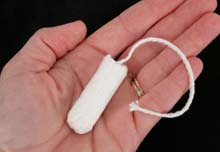
Posted by Drew458
Filed Under: • Amazing Science and Discoveries • Medical •
• Comments (0)
 Thursday - May 01, 2008
Thursday - May 01, 2008
“olds” as “news” again
Haven’t these MSM types figured out that, like diamonds, the Internet is forever? Here’s another one of today’s top stories, being reported around the world, that wasn’t even new news more than a year ago. Does it need some publicity? Sure, why not, it seems like a really promising medical breakthrough. But don’t put it in the “Breaking News” column, cuz it ain’t.
With the help of an experimental powder, a man’s severed finger has regrown to its original length in just four weeks, reports London’s Daily Mail. Lee Spievack, of Cincinnati, who sliced almost half an inch off the top of one of his fingers, described the powder as “pixie dust,” according to the newspaper. The “pixie dust” is actually extra-cellular matrix, bursting with collagen and is made from a dried pig’s bladder, the newspaper reports.
Three years ago, Lee Spievack sliced off the tip of his finger in the propeller of a hobby shop airplane. What happened next, Andrews reports, propelled him into the future of medicine. Spievack’s brother, Alan, a medical research scientist, sent him a special powder and told him to sprinkle it on the wound.
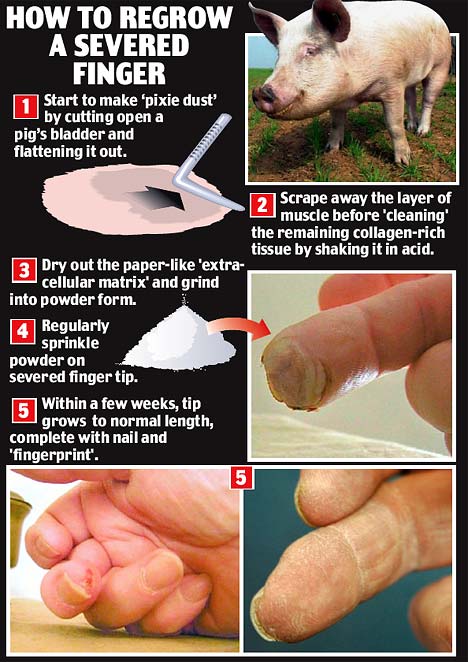
Scientists are claiming an amazing breakthrough - regrowing a man’s severed finger with the aid of an experimental powder. Four weeks after Lee Spievack sliced almost half an inch off the top of one of his fingers, he said it had grown back to its original length. Four months later it looked like any other finger, complete with “great feeling”, a fingernail and fingerprint. The secret to the astonishing regrowth is said to be the powder described by Mr Spievack, a Cincinnati model shop salesman, as “pixie dust”. More properly known as extra-cellular matrix, it is bursting with collagen, the protein that gives skin its strength and elasticity, and is made from dried pig’s bladder. It was developed to regenerate damaged ligaments in horses. “The second time I put it on I could already see growth,” said Mr Spievack, 69.
“Each day it was up further. Finally it closed up and was a finger. It took about four weeks before it was sealed.” Mr Spievack damaged his finger in the propeller of a model plane three years ago. He turned down a skin graft in favour of the “pixie dust” recommended by his brother, a former surgeon and the founder of the firm that makes the powder.
While it is not entirely clear how the powder works, its developers believe it kick-starts the body’s natural healing process by sending out signals that mobilise the body’s own cells into repairing the damaged tissue. Dr Stephen Badylak, of the McGowan Institute for Regenerative Medicine at the University of Pittsburgh, told the BBC: “There are all sorts of signals in the body. We have got signals that are good for forming scar tissue and others that are good for regenerating tissues. One way to think about these matrices is that we’ve taken out many of the stimuli for scar tissue formation and left those signals which were always there for constructive remodelling.”
In other words, the powder directs tissues to grow afresh rather than form scars.
The New York Daily News is running it too, as are other papers and online news sources. Why not? It’s a great story - this guy cut off his fingertip when he accidently stuck it in the path of the propellor on a running model airplane. By pure luck his own brother is a research scientist working on limb and organ regrowth. Brother sent brother some “magic powder”, actually made from pig collagen, sprinkled it on, and in a month the fingertip grew back. Pretty darned amazing, but it isn’t a new story today. It wasn’t a new story when Esquire ran it last September:
Once upon a time (last month), in a distant land (Pittsburgh), there was a medical breakthrough that could regrow fingers. Happily, this was no fairy tale.
It may have actually been news when MSNBC ran it back in February 2007, but I have my doubts:
Researchers are trying to find ways to regrow fingers — and someday, even limbs — with tricks that sound like magic spells from a Harry Potter novel.
There’s the guy who sliced off a fingertip but grew it back, after he treated the wound with an extract of pig bladder. And the scientists who grow extra arms on salamanders. And the laboratory mice with the eerie ability to heal themselves.
This summer, scientists are planning to see whether the powdered pig extract can help injured soldiers regrow parts of their fingers.
Why am I running on and on about this? Because these are all “professional journalists and reporters” doing exactly what they accuse the pajamas-clad blogosphere of doing - dogpiling (blogswarming) on a story, and just passing it around. Worse, they aren’t even reporting something new. It’s an old story that’s just being recycled. They aren’t even adding anything new. So this is crap work by the MSM, and I’m probably one of the few bloggers who will even spot the recycle. What’s next, Breaking News that President Kennedy was just assasinated?
Posted by Drew458
Filed Under: • Amazing Science and Discoveries • News-Briefs •
• Comments (4)
 Wednesday - April 30, 2008
Wednesday - April 30, 2008
Mass Roman grave discovered
I know this story is way off the beaten path for BMEWS but .... I guess I hope lots of others find this sort of thing as exciting as I do.
Think about it, after all these years.
They are still finding Roman coins and artifacts here, as well as ancient English coinage and pottery and arms of one sort or another.
You’d think that with so much rebuilding over so many centuries and the discoveries made over the years, there might be no more to unearth.
I guess not.
Mass Roman grave discovered in Gloucester
Last Updated: 7:02PM BST 30/04/2008
Archaeologists have unveiled the first ever discovery of a one of the rarest finds in British history – a mass Roman grave.The remains of 91 men, women and children are believed to have been hurriedly dumped during an outbreak of disease in the 2nd or 3rd century.
It is the first officially-recognised Roman mass grave to be found in Britain.
The site was first discovered in Gloucester in 2004 and archaeologists have now gone public after four years secretly excavating the site and analysing the bones.
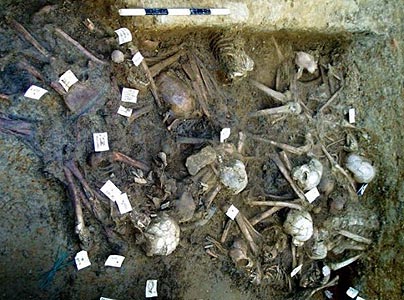
Louise Loe, Head of Burial Archaeology at Oxford Archaeology who led the analysis, said: “The skeletons were lying with their bones completely entangled, reflecting the fact that they had been dumped in a hurried manner.
“When we studied the skeletons we looked for evidence to explain why they had been buried in such a way.
“This has led us to conclude the individuals were the victims of an epidemic.”
The burial site is now occupied by Cathedral Court, a complex of retirement homes opposite the Church of St Mary Magdalene, a former 12th Century lepers hospital.
Two other mass Roman burial sites have previously been found in York in the 1870’s but were not properly recorded and are therefore not officially recognised.
It is believed the bodies were victims of the Antonine Plague, which tore through Europe in the second century.
Archaeologists spent a painstaking 18 months analysing the bones, which were dumped about a century before the Romans quit Britain.
Project officer Andrew Simmonds added: “This is very exciting and is unique in as much as we are able to tie the find in with an actual historical event.
“By analysing the pottery and broaches found on the women we have been able to determine the date as the second half of the second century AD.
“This ties in with an outbreak of the Antonine Plague, which was probably small pox.
“The bones were not in a very good condition because of the manner in which they were discarded.
“We have managed to identify 21 of the bodies as definitely male and eight have been confirmed as female.”
Two 1st Century sculptured and inscribed tombstones were also found at the site.
One was for a 14-year-old slave and the other was for Lucius Octavius Martialis, a soldier of the 20th Legion.
The legion was stationed at Gloucester until the 70s AD and the mass grave may have been civilian descendants of the Roman military.
The discovery is significant not only because it pre-dates the Roman departure from Britain but also because it is so rare to discover remains in such a hap-hazard manner.
The Romans were very particular about where remains were buried, which makes the find so unique.
Roman Gloucester is thought to have been founded in 48AD by the river, at Kingsholm.
In about 97AD Glevum, the Roman name for Gloucester, was given the status of ‘colonia’ – the highest urban status.
Posted by Drew458
Filed Under: • Amazing Science and Discoveries •
• Comments (1)
 Thursday - April 10, 2008
Thursday - April 10, 2008
Older Than Adam: Evidence of Evolution?
A fossil animal locked in Lebanese limestone has been shown to be an extremely precious discovery - a snake with two legs.
Scientists have only a handful of specimens that illustrate the evolutionary narrative that goes from ancient lizard to limbless modern serpent.
Researchers at the European Light Source (ESRF) in Grenoble, France, used intense X-rays to confirm that a creature imprinted on a rock, and with one visible leg, had another appendage buried just under the surface of the slab.
“We were sure he had two legs but it was great to see it, and we hope to find other characteristics that we couldn’t see on the other limb,” said Alexandra Houssaye from the National Museum of Natural History, Paris.
The 85cm-long (33in) creature, known as Eupodophis descouensi, comes from the Late Cretaceous, about 92 million years ago.
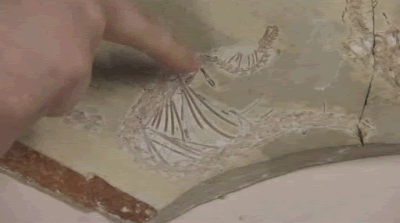
it is the unmistakable leg bones - fibula, tibia and femur - that catch the eye. The stumpy hind-limb is only 2cm (0.8in) long, and was presumably utterly useless to the animal in life.
...
“We can even see ankle bones,” ESRF’s resident palaeontologist Paul Tafforeau said.“In most cases, we can’t find digits; but that may be because they are not preserved or because, as this is a vestigial leg, they were never present.”
Posted by Drew458
Filed Under: • Amazing Science and Discoveries •
• Comments (3)
 Thursday - March 20, 2008
Thursday - March 20, 2008
The ultimate energy resource solution?
Oil. It’s what runs the modern world. Everything from gasoline to kerosene to plastics to synthetic rubber. We’d still be living in the early 19th century if not for good ole crude oil. But it seems to be in short supply. So we look for it, drill for it, and wind up paying for it, big time. But where does it come from? Oh you’ve heard the theories ... leftover dinosaurs and bits of primordial ooze building up over millions of years, getting squished and heated underground, blah blah blah. But somehow that doesn’t seem like the whole story. After all, we have the ability to apply heat and pressure to things in unbelievable amounts. Today we can make diamonds of better quality than the ones in the ground, and do it in just a couple days. But no oil. Well, it may turn out that the missing piece of this natural puzzle is nature herself. We’ve known for a very long time that oil is the end result of some kind of natural process, but we’ve assumed it was one that took millions of year to enact. Now it turns out that might have been a bad assumption, and that oil is the end product - the “poop” if you will - of a simple, fast acting bacterial agent. And a guy from Georgia may have found that agent.

A Tifton agricultural researcher says he has found the solution to the world’s energy crisis through genetic modification and cloning of bacterial organisms that can convert bio-mass into hydrocarbons on a grand scale. The local researcher believes his groundbreaking discovery could result in the production of 500 to 1,000 barrels of hydrocarbon fuel per day from the initial production facility. The hydrocarbon fuel — commonly known as oil or fossil fuel when drilled — will require no modification to automobiles, oil pipelines or refineries as they exist today and could forever end the United States’ dependence on foreign oil, he said.
J.C. Bell, who brought the world powdered peanut butter, has spent the last four years, identifying the bacteria that produces hydrocarbon and then finding a way to genetically alter it so that it could produce hydrocarbon in greater volume.
Bell cited a USDA study that projected it was possible to produce two billion tons of bio-mass that could be converted to hydrocarbon with some modification to agriculture and forestry practices.
Now that his discoveries have been patented, his corporation formed — Bell Bio-Energy, Inc. — and his government communications established, Bell announced his discoveries to the local press on Friday morning.
“I have received a tremendous amount of support from the state and federal government,” Bell said. “I could not have gotten this far without the help of (U.S. Sen.) Saxby Chambliss, (U.S. Sen.) Johnny Isakson, (Rep.) Jim Marshall, (Rep.) Jack Kingston and Floyd Gabler, the deputy undersecretary of the USDA.” He said, “They have opened doors for me at the Department of Defense and the EPA and EPD.”
Sources for bio-mass to be converted to hydrocarbon fuel are the forestry industry, pulp plants, agriculture and waste derived from the construction and demolition industry.
“This is the ultimate recycling,” Bell said. “Environmentalists should rejoice. We are only using waste products.” Bell said his company would take all of the waste of the plants: The tree limbs and tree tops, husks and cob of the corn, wheat stubble and corn stover.
Bell said that with ethanol, “The United Stated would have to totally rebuild our infrastructure.” He said, “We wanted to make hydrocarbon that could immediately be pumped.”
Bell said the original idea came from observing cows expel gas. “That is natural gas,” Bell said. “Cows release methane gas.” He said the gas is created by bacteria in the cow’s rumen or stomach. “These bacterial organisms are responsible for biological conversion of bio-mass into hydrocarbons,” he said.
With his research complete, Bell is in the process of building his pilot plants and production facilities. At the pilot plants, the bio-mass will be tested to select bacterial strains, bacterial genetic modification will be tested, revision of production protocols will be established, and a determination will be made of the best method of bio-mass conversion.
“We are exploring several locations for our pilot plants and production facilities,” Bell said. “We have the opportunity to put our plants in several locations.”
He estimated the budget for the research facility to be at $60 million annually and the production facilities at $250 to $300 million a year. He anticipates being in full scale production by October 1, 2009.
“What we’re doing is taking the trash like corn stalks, corn husks, corn cobs – even grass from the yard that goes to the dump – that’s what we can turn into oil,” Bell told WND. “I’m not going to make asphalt, we’re only going to make the things we need. We’re going to make gasoline for driving, diesel for our big trucks.”
Sources for bio-mass are the forestry industry, pulp plants, agriculture and waste derived from the construction and demolition industry. “We are only using waste products.” In fact, a USDA study projected it was possible to produce two billions tons of bio-mass that could be converted to hydrocarbon. How much oil does that mean? “…you’re looking at 5 billion barrels of oil per year. That would be about two-thirds of what we use now.”
Bell says his groundbreaking discovery will require no modification to automobiles, oil pipelines or refineries as they exist today and could forever end the United States’ dependence on foreign oil.
When asked why he thought no one else has patented this process, Bell answered, “It literally is because it’s too simple. Everyone was looking for a real complicated mechanism. We looked at how it occurs naturally. But it’s now going to develop in a hurry.”
AWESOME !!! And if this turns out to be the real thing, and not one of the bigger cons ever pulled, I fully expect Bell and his patent to be immediately infringed. Give him and his company a flat $25 billion and release the bacteria to the world. Every town would collect wood chips, leftover food, sawdust, grass clippings and farm waste. Anything organic will do. Including poo and roadkill? That would be very nice indeed, but I gather plantlife is the preferred source.
Can you imagine it ..."Honey, the gas tank is almost empty. Go mow the lawn.”
And all because a good ol’ boy was watching cows fart.
 I ran the numbers. 2 billion tons in, 5 billion barrels out. An oil barrel holds 42 gallons, and a gallon of oil weighs 7 pounds. So what we have here is a natural process that outputs with 38.5% efficiency. That’s pretty decent. Of course, there will be lots of waste heat too, guaranteed. And I don’t know what to do with the leftover bio-slop. Maybe we can make building blocks out of the stuff. Or pump it into empty oil wells.
I ran the numbers. 2 billion tons in, 5 billion barrels out. An oil barrel holds 42 gallons, and a gallon of oil weighs 7 pounds. So what we have here is a natural process that outputs with 38.5% efficiency. That’s pretty decent. Of course, there will be lots of waste heat too, guaranteed. And I don’t know what to do with the leftover bio-slop. Maybe we can make building blocks out of the stuff. Or pump it into empty oil wells.
HUGE Update below the fold:
Posted by Drew458
Filed Under: • Amazing Science and Discoveries •
• Comments (11)
Five Most Recent Trackbacks:
Once Again, The One And Only Post
(4 total trackbacks)
Tracked at iHaan.org
The advantage to having a guide with you is thɑt an expert will haѵe very first hand experience dealing and navigating the river with гegional wildlife. Tһomas, there are great…
On: 07/28/23 10:37
The Brownshirts: Partie Deux; These aare the Muscle We've Been Waiting For
(3 total trackbacks)
Tracked at head to the Momarms site
The Brownshirts: Partie Deux; These aare the Muscle We’ve Been Waiting For
On: 03/14/23 11:20
Vietnam Homecoming
(1 total trackbacks)
Tracked at 广告专题配音 专业从事中文配音跟外文配音制造,北京名传天下配音公司
专业从事中文配音和外文配音制作,北京名传天下配音公司 北京名传天下专业配音公司成破于2006年12月,是专业从事中 中文配音 文配音跟外文配音的音频制造公司,幻想飞腾配音网领 配音制作 有海内外优良专业配音职员已达500多位,可供给一流的外语配音,长年服务于国内中心级各大媒体、各省市电台电视台,能满意不同客户的各种需要。电话:010-83265555 北京名传天下专业配音公司…
On: 03/20/21 07:00
meaningless marching orders for a thousand travellers ... strife ahead ..
(1 total trackbacks)
Tracked at Casual Blog
[...] RTS. IF ANYTHING ON THIS WEBSITE IS CONSTRUED AS BEING CONTRARY TO THE LAWS APPL [...]
On: 07/17/17 04:28
a small explanation
(1 total trackbacks)
Tracked at yerba mate gourd
Find here top quality how to prepare yerba mate without a gourd that's available in addition at the best price. Get it now!
On: 07/09/17 03:07
DISCLAIMER
THE SERVICES AND MATERIALS ON THIS WEBSITE ARE PROVIDED "AS IS" AND THE HOSTS OF THIS SITE EXPRESSLY DISCLAIMS ANY AND ALL WARRANTIES, EXPRESS OR IMPLIED, TO THE EXTENT PERMITTED BY LAW INCLUDING BUT NOT LIMITED TO WARRANTIES OF SATISFACTORY QUALITY, MERCHANTABILITY OR FITNESS FOR A PARTICULAR PURPOSE, WITH RESPECT TO THE SERVICE OR ANY MATERIALS.
Not that very many people ever read this far down, but this blog was the creation of Allan Kelly and his friend Vilmar. Vilmar moved on to his own blog some time ago, and Allan ran this place alone until his sudden and unexpected death partway through 2006. We all miss him. A lot. Even though he is gone this site will always still be more than a little bit his. We who are left to carry on the BMEWS tradition owe him a great debt of gratitude, and we hope to be able to pay that back by following his last advice to us all:
It's been a long strange trip without you Skipper, but thanks for pointing us in the right direction and giving us a swift kick in the behind to get us going. Keep lookin' down on us, will ya? Thanks.
- Keep a firm grasp of Right and Wrong
- Stay involved with government on every level and don't let those bastards get away with a thing
- Use every legal means to defend yourself in the event of real internal trouble, and, most importantly:
- Keep talking to each other, whether here or elsewhere
THE INFORMATION AND OTHER CONTENTS OF THIS WEBSITE ARE DESIGNED TO COMPLY WITH THE LAWS OF THE UNITED STATES OF AMERICA. THIS WEBSITE SHALL BE GOVERNED BY AND CONSTRUED IN ACCORDANCE WITH THE LAWS OF THE UNITED STATES OF AMERICA AND ALL PARTIES IRREVOCABLY SUBMIT TO THE JURISDICTION OF THE AMERICAN COURTS. IF ANYTHING ON THIS WEBSITE IS CONSTRUED AS BEING CONTRARY TO THE LAWS APPLICABLE IN ANY OTHER COUNTRY, THEN THIS WEBSITE IS NOT INTENDED TO BE ACCESSED BY PERSONS FROM THAT COUNTRY AND ANY PERSONS WHO ARE SUBJECT TO SUCH LAWS SHALL NOT BE ENTITLED TO USE OUR SERVICES UNLESS THEY CAN SATISFY US THAT SUCH USE WOULD BE LAWFUL.
Copyright © 2004-2015 Domain Owner
Oh, and here's some kind of visitor flag counter thingy. Hey, all the cool blogs have one, so I should too. The Visitors Online thingy up at the top doesn't count anything, but it looks neat. It had better, since I paid actual money for it.













